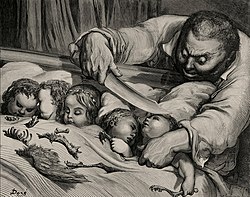Ogre

An ogre (feminine: ogress) is a large, mean and hideous humanoid monster. Ogres are often depicted in fairy tales and folklore as feeding on human beings, and have appeared in many classic works of literature. In art, ogres are often depicted with a large head, abundant hair and beard, a huge belly, and a strong body. The term is often applied in a metaphorical sense to disgusting persons who exploit, brutalize or devour their victims.
The term "ogre" can also mean a feared, overauthoritative, and abusive person.
Etymology
The word ogre is of French derivation, and was originally believed to have been coined by either Charles Perrault (1628-1703) or Marie-Catherine Jumelle de Berneville, Comtesse d' Aulnoy (1650-1705), both of whom were French authors. Other sources say that the name is derived from the word Hongrois, which means Hungarian.[1] Nowadays, the word is thought to have been actually inspired by the works of Italian author Giambattista Basile (1575-1632), who used the Neapolitan word uerco, in standard Italian orco. This word is documented [1] in earlier Italian works (Fazio degli Uberti, XIV cent.; Luigi Pulci, XV; Ludovico Ariosto, XV-XVI) and has even older cognates with the Latin orcus and the Old English orcnēas found in Beowulf lines 112-113, which inspired J.R.R. Tolkien's Orc. [2] All these words may derive from a shared Indo-European mythological concept (as Tolkien himself speculated, as cited by Tom Shippey, The Road to Middle-earth, 45).
The first appearance of the word ogre in Perrault's work occurred in his Histoires ou Contes du temps Passé (1697). It later appeared in several of his other fairy tales, many of which were based on the Neapolitan tales of Basile. The first example of a female ogre being referred to as an ogress is found in his version of Sleeping Beauty, where it is spelled ogresse.. The Comtesse d' Aulnoy first employed the word ogre in her story L'Orangier et l' Abeille (1698), and was the first to use the word ogree to refer to the creature's offspring.
Ogres in modern fiction
Literature for children is rife with tales involving ogres and kidnapped princesses who were rescued by valiant knights and, sometimes, peasants. Ogres are also popular in fantasy fiction, such as C.S. Lewis's The Chronicles of Narnia, and in various fantasy games.
- The protagonist of the film Shrek is an ogre. Shrek is voiced by Mike Myers, using a cartoonish Scottish accent. Shrek is not a stereotypically hostile ogre. He is not a villain, but an ogre that lives in a swamp and prefers not to be disturbed.
- In Disney's Adventures of the Gummi Bears, there is an army of villainous ogres residing in Castle Drekmore and led by Duke Igthorn, who attempt to conquer King Gregor and Dunwyn Castle.
- In the movie Time Bandits, the protagonists are found by an ogre and his wife on the ogre's ship. The ogre is outwitted and left at sea after the protagonists commandeer the ship.
- In the Xanth Chronicles by Piers Anthony, ogres are stupid beasts with immense strength that communicate almost exclusively through rhyme as in the Chronicle Ogre, Ogre. At several points in A Spell for Chameleon, the first Xanth novel, the lead character worries that the women he encounters are actually female ogres in human form.
- In the Spiderwick Chronicles (the fifth book), Mulgarath, the primary antagonist, is an evil ogre who wants to enslave the world, ridding it of all humans.
- In Tamora Pierce's books that revolve around Tortall, there are two kinds of ogres: peaceful farmers and warlike monsters. Both types are extremely tall and often seem menacing. In her book Wolf-Speaker, the peaceful "breed" are slaves who mine black opals.
- A Book of Ogres and Trolls by Ruth Manning-Sanders contains 13 fairy tales.
- On Queen's second album (Queen II), the first song on Side Black (Side 2) is "Ogre Battle", penned by Freddie Mercury. The lyrics describe one of the ogres as giving "a great big cry, and he can swallow up the ocean. With a mighty tongue he catches flies, and the palm of his hand is an incredible size. One great big eye has a focus in your direction..." It is unclear if the lyric means that the ogre is a cyclops or simply missing its second eye. Mercury was well-read and quite a fan of mythology and fairy-tales, so it is quite reasonable to assume the lyric is deliberate, rather than unintentionally vague.
Ogre is often used metaphorically as well, as in the association of ogres with Nazis made in Michel Tournier's novel Le Roi des aulnes (1970; The Ogre). Other modern works depicting ogres include L'Ogre (1973) by Jacques Chessex, and Nacer Khemir's L'Ogresse (1975), a collection of Tunisian tales.
- There are various ogrelike Digimon, most notably Ogremon, as well as Grumblemon, Fugamon and Hyogamon.
Ogres in modern games
Ogres appear in many popular fantasy roleplaying and video games series such as AdventureQuest, DragonFable, Dungeons & Dragons, The Elder Scrolls IV: Oblivion, Eternal Lands, EverQuest, Final Fantasy, Magic: The Gathering, Ogre Battle, RuneScape, Tekken 3, Two Worlds, Warcraft, and Warhammer Fantasy. See also Ogre (disambiguation).
See also

- Fictional Ogres
- Ogre (Warcraft)
- Giant
- Homo heidelbergensis
- Oni
- Troll
- Fomor
- Orc
- Cyclops
- Monster
- Kaiju
References
- Rose, Carol. Giants, Monsters, & Dragons: An Encyclopedia of Folklore, Legend, and Myth. New York: W. W. Norton & Company, 2001. ISBN 0-393-32211-4
- Shippey, Tom. The Road to Middle-earth. London: HarperCollins, 1992 (rev.). ISBN 0-261-10275-3
- South, Malcom, ed. Mythical and Fabulous Creatures: A Source Book and Research Guide. Westport, CT: Greenwood Press, 1987. Reprint, New York: Peter Bedrick Books, 1988. ISBN 0-87226-208-1
- "Ogre." Encyclopædia Britannica. 2006. Encyclopædia Britannica Online. 15 May 2006 <http://www.search.eb.com/eb/article-9125639>
- ^ Dictionnaire de l'Académie française, (1932-1935)
